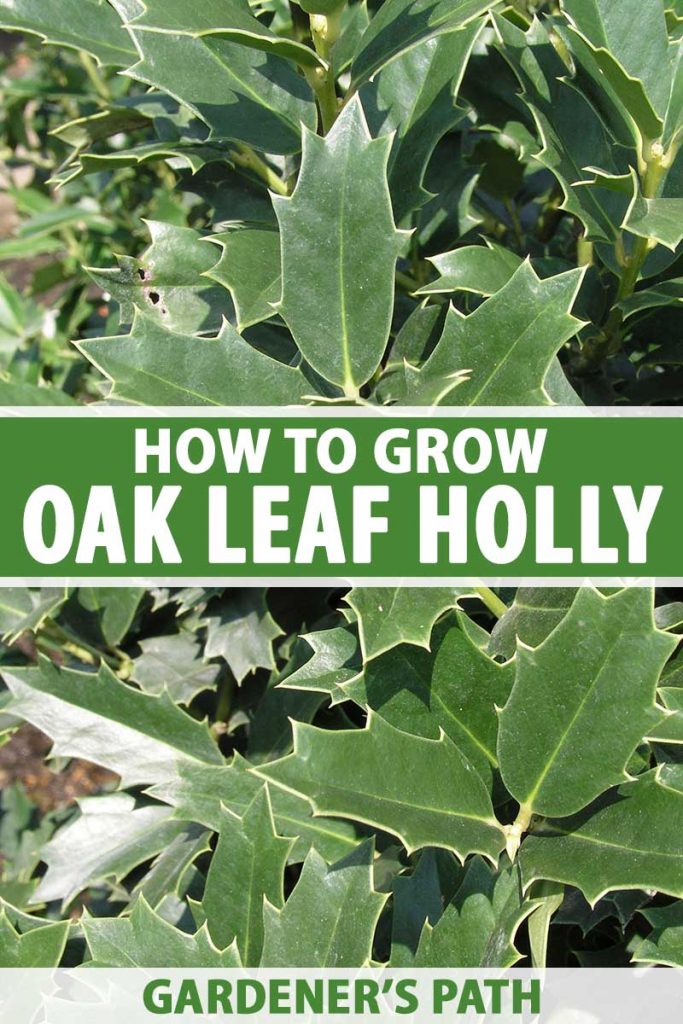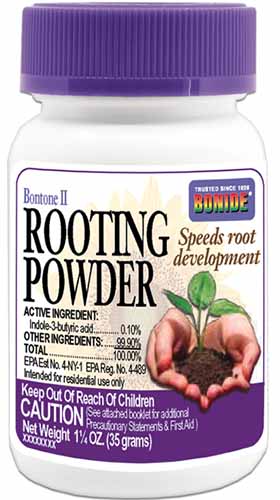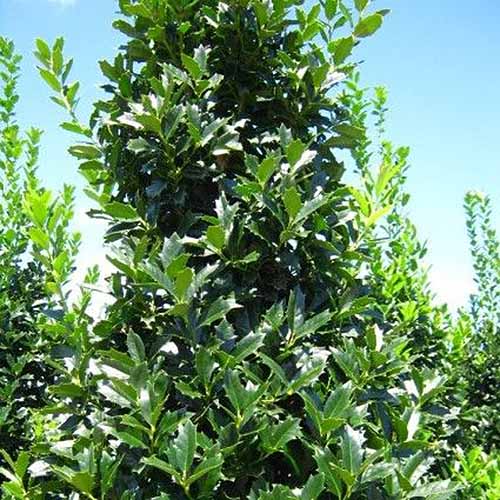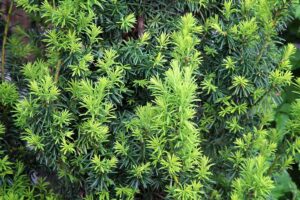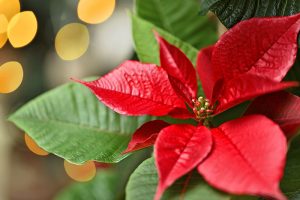Ilex x ‘Conaf’
Oak Leaf holly is a fast-growing, evergreen shrub with glossy foliage that produces bright red berries in autumn, and provides year-round interest in the garden.
Named for the unique, shapely leaves that resemble those of an oak tree, Oak Leaf holly (Ilex x ‘Conaf’) reaches a mature height of 10-15 feet with a spread of seven to nine feet.
So if you love the shape of oak leaves but don’t want to plant a giant tree in your yard, just as there exists a holly oak, which is an oak tree with holly-like leaves, you’ll be pleased to discover there is also an Oak Leaf holly!
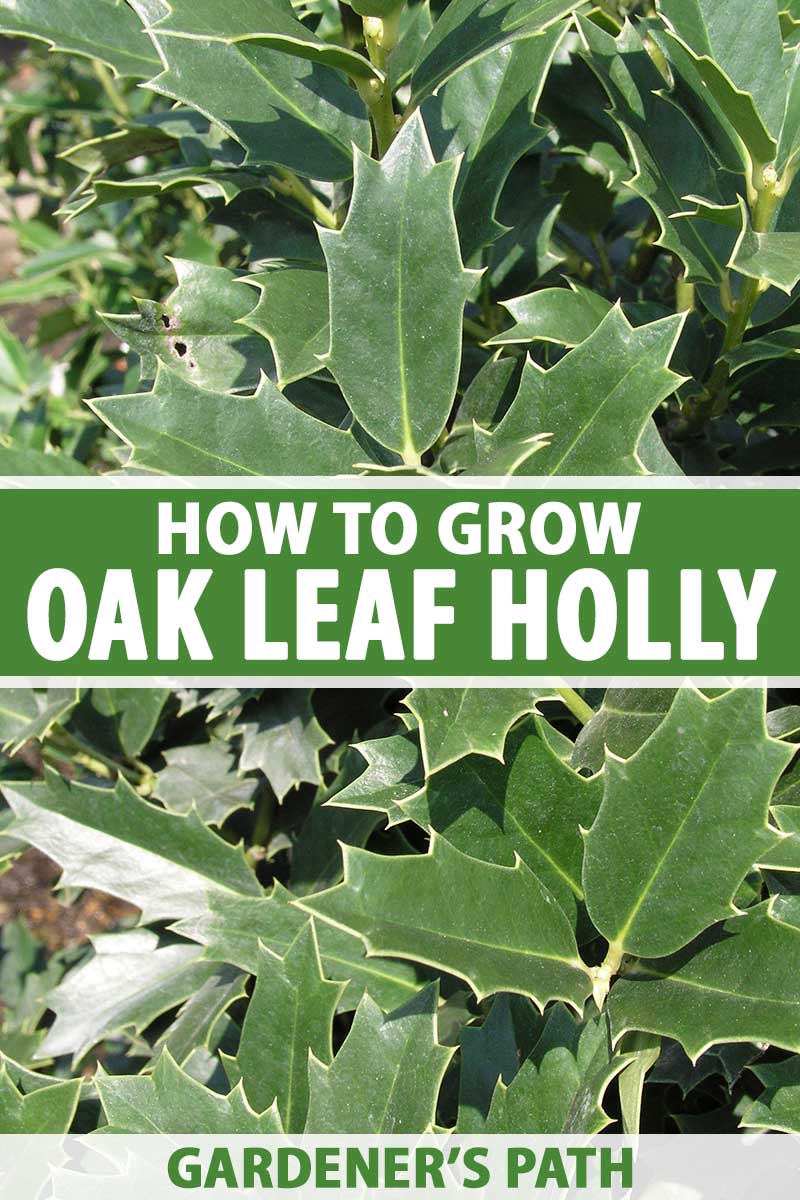
We link to vendors to help you find relevant products. If you buy from one of our links, we may earn a commission.
A perfect, not-too-huge addition to your yard, Oak Leaf holly grows naturally in a pyramid shape and responds well to pruning, should you prefer to grow it as a formal hedge or privacy screen.
Ready to learn all about these stately plants? Here’s what we’ll cover:
What You’ll Learn
What Is Oak Leaf Holly?
Ilex is a large genus in the Aquifoliaceae, or holly family, and Oak Leaf is a hybrid cultivar that delivers pleasing color to gardens in USDA Hardiness Zones 6 to 9.
The evergreen foliage emerges in a rusty-red color before maturing into a deep emerald green with prickly leaves that have a darker center and subtly lighter edges. Each leaf has three to five serrated margins, with small, sharp prickles on the ends.
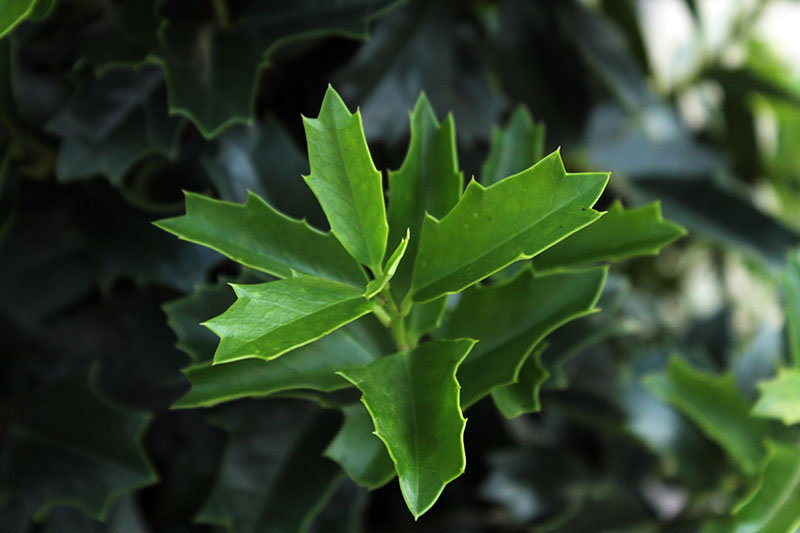
Delicately scented cream-white flowers bloom in spring and then produce small green berries that turn into red-orange, 3/8-inch beauties in the fall.
And unlike most hollies that are either male or female, this hybrid is a hermaphrodite, with both female and male reproductive structures on each flower, so it doesn’t require another plant nearby in order to set fruit.
The berries last for much of the winter, adding plenty of interest to your yard and providing food for birds.
A Note of Caution: The berries are toxic to humans and animals and no part of the plant should be ingested.
Cultivation and History
This stalwart, pleasing shrub is one of five hybrid cultivars in the Red Holly™ series selected from Ilex x ‘Mary Nell’ in the 1990s by Jack Magee, a plant breeder at Evergreen Nurseries in Mississippi.
‘Mary Nell’ is, herself, the product of three parents: the female plant was a cross between I. cornuta, a heat-tolerant Chinese holly, and I. pernyi, aka Perny holly that has small, spiny leaves. The male was I. latifolia, or Lusterleaf holly, which has large, broad, blue-green leaves.
Oak Leaf is the result of open pollination of ‘Mary Nell’ and the male parent plant is unknown.
The cultivar was originally patented in 1995 as ‘Conaf,’ but the plant is marketed under the trademarked name Oak Leaf.
The other Red Holly™ cultivars hybridized from ‘Mary Nell’ are ‘Cardinal,’ ‘Festive,’ ‘Little Red,’ and ‘Robin.’ Like Oak Leaf, all these are evergreen shrubs suitable for cultivation in Zones 6-9.
Propagation
As it’s a hybrid, you won’t be able to grow this shrub from seed, so you’ll either need to purchase a plant from the nursery for transplanting or take cuttings from an existing plant.
Stem cuttings will produce clones of the parent plant. Here’s how to do it:
From Stem Cuttings
For best success, you’ll need to take cuttings from softwood stems. Before you begin, fill a few eight-ounce, clear plastic cups with a mixture of perlite and peat moss.
Spray the potting medium with a misting bottle in order to moisten it.
Put on long gardening gloves to protect your arms from the prickly foliage, find a section of new growth, and cut a three- to five-inch length of stem. Repeat a few more times to take as many cuttings as you want.
Use a clean knife or pruning shears to remove all the leaves except for two or three at the tip of the cuttings.
Gently scrape the bark away from the bottom half-inch of the stem with a knife and dip the cut end in rooting hormone gel or powder, such as Bontone II, available from Arbico Organics.
Immediately place one cutting in each pre-filled cup, burying it an inch or two deep. To maintain a humid environment, you can place a dome over each cup to trap the moisture inside, or use plastic ziptop bags secured with an elastic band.
Set the containers in a warm area, ideally at a temperature of 70-80°F, that receives indirect sunlight. Spray the potting medium with water twice a day to keep the cuttings moist.
After about six to eight weeks, you can check whether your cutting has taken root by gently tugging the stem. If you feel some resistance, it’s time to repot into a larger container.
Transplant each cutting to an eight-inch pot filled with fresh potting soil and put them in a sunny indoor location or in a greenhouse. Water when the top inch of soil is dry.
Make sure the cuttings receive at least six hours of sunlight each day, or eight to ten hours of light from a grow light, which isn’t quite as strong as sunlight.
A year after propagation, in late summer or early fall, start hardening the plants off by putting them outdoors for an increasing amount of time every day until they can stay outdoors in indirect light for eight-hour stretches.
At that point, you can transplant your baby holly plants into their permanent place in your yard or garden.
Transplanting
If you have purchased a plant from a garden center or nursery, the best time to transplant out into the garden is in late summer or early autumn, to give the roots time to establish before winter hits.
Oak Leaf holly plants can spread seven to nine feet wide, so make sure you give each shrub enough space to grow and thrive. Or if you want to grow a dense hedge, position each plant five to six feet apart.
To transplant a nursery shrub or year-old cutting into your yard or garden, dig a hole as deep and wide as the root ball and amend the soil with a mixture of compost and peat moss.
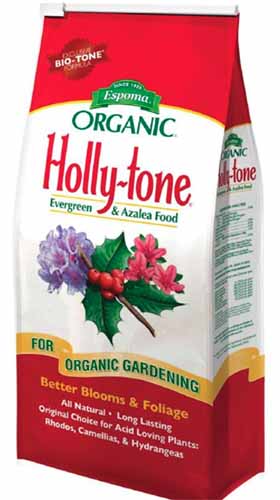
Alternatively, you can add Espoma’s Holly-tone fertilizer 4-3-4 (NPK), which is made for acid-loving shrubs, available at the Home Depot. Follow package instructions when applying the fertilizer.
Loosen the root ball and remove it from the nursery pot. Place it in the hole and backfill with soil. Water thoroughly, and you’re done! These quick-growing shrubs will soon make their bold statement in your yard.
How to Grow
Oak Leaf holly is easy to grow in a full or part sun location and well-draining, organically rich, slightly acidic soil. You can conduct a soil test to make sure your soil is in the 5.0-6.5 pH range.
If you need to make the soil more acidic, you can apply granular sulphur according to package instructions to help lower the pH.
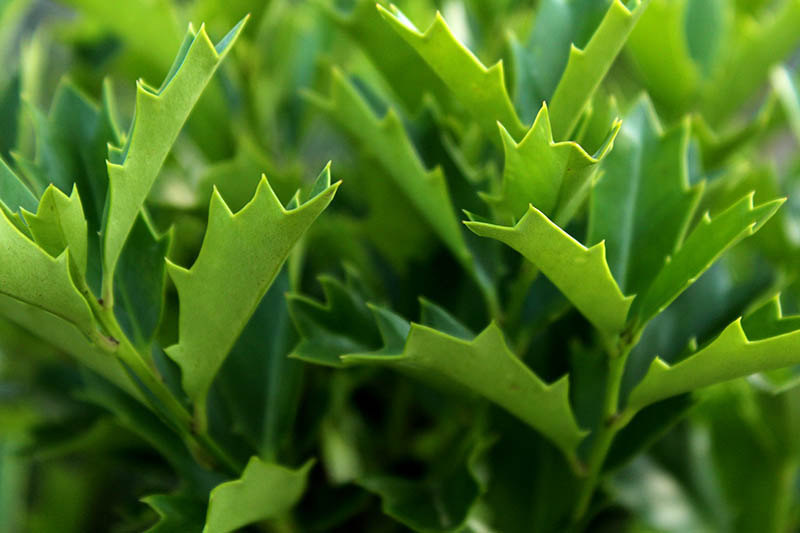
They are tough plants that will tolerate a range of soils, including sandy or clay, and once established, they don’t need too much attention from you to thrive.
It’s smart to get that soil test done before you plant because one of the problems these shrubs can face is leaf drop, yellowing, and leaf scorch if they are grown in soil with a pH that’s over 6.5.
New transplants require even moisture, so keep an eye on them if there’s no rain. When you notice new growth, slow to watering only when the top inch of the soil dries out, about one or two inches of water per week.
Don’t let the soil dry out completely, though. Established plants can tolerate a little bit of dryness but not a full-on drought. And if they don’t get enough moisture, they may not flower and form those lovely red-orange fruits.
You can apply a layer of straw or bark mulch to help with moisture retention and to keep the roots protected from winter temperature changes.
Growing Tips
- Plant in a full sun location.
- Make sure the soil pH is between 5.0 and 6.5.
- Provide one or two inches of water per week, including rainfall.
Pruning and Maintenance
This shrub responds well to a thorough pruning if you want it to maintain a specific shape or create a hedge.
Just keep in mind that unless you prune in the winter, when the plant is dormant, it may produce fewer berries the following year. This is because it develops buds for next year on the new growth, while the old growth supports the berries.
You don’t have to prune this shrub at all. It takes on a pleasing pyramid shape if left to grow uninhibited. Plus, it produces lots of beautiful berries to look at all winter long.
To keep the plant healthy, trim away any dead, broken, or diseased branches during winter dormancy, and thin any intersecting or crossing branches to increase airflow.
You can feed your plants in the spring and fall using Espoma Holly-tone, mentioned above, or other fertilizer suitable for acid-loving plants such as azaleas.
Where to Buy
Ready to get your hands on Oak Leaf holly to plant in your garden?
You can find two- to four-year-old plants, in #3 containers available at Nature Hills Nursery.
Managing Pests and Disease
Like most evergreen holly shrubs, Oak Leaf doesn’t typically fall prey to pest infestations and disease, particularly when it’s established and healthy.
Luckily, herbivores aren’t much of a problem as deer will give it a wide berth, and rabbits will dine elsewhere.
Pests
There are a couple of pests to watch out for when you’re growing Oak Leaf holly.
The holly leaf miner (Phytomyza ilicicola), a pest that commonly plagues our evergreen shrub, is a small fly that lays its eggs inside the leaves. The larvae then tunnel through them, which can kill the foliage, though typically this will not kill the plant.
Remove all the fallen and infested leaves and spray the plant with insecticidal soap to ward off large infestations.
Another insect to watch out for is the whitefly (Trialeurodes vaporariorum), a small white, winged insect that sucks the sap from the leaves and excretes honeydew, which can lead to unsightly sooty mold developing on the leaves.
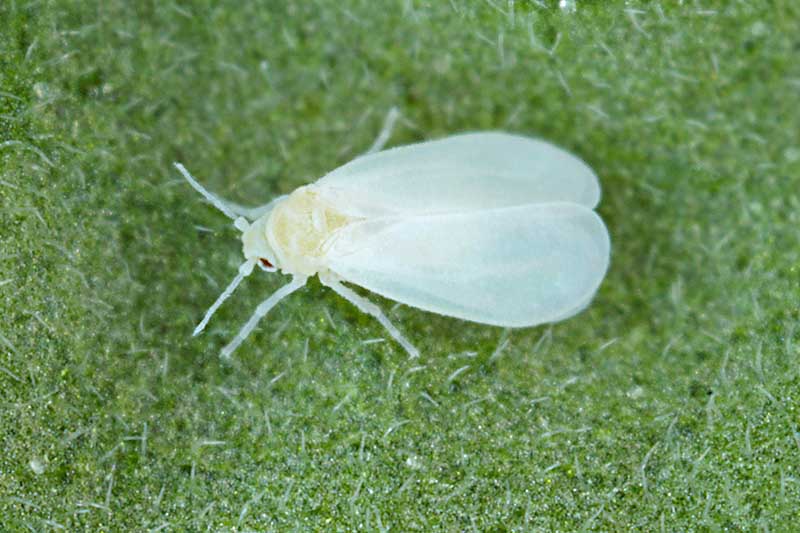
You can spray with neem oil or apply insecticidal soap to manage whitefly infestations.
In addition to leaf miners and whiteflies, these shrubs are sometimes infested by spider mites and scale insects.
Disease
Diseases that can attack your plant include leaf spot caused by the fungus Coniothyrium ilicinum, which causes small dark-brown spots to appear on the leaves. Tar spot, another fungal infection caused by Phacidium curtisii, produces very similar looking dark or reddish-brown spots on the leaves.
To prevent these fungal issues, avoid overhead watering and make sure you don’t oversaturate the soil.
To fight off existing infections, remove the affected foliage and spray the remainder of the plant with copper fungicide spray, available from Arbico Organics, according to package instructions.
Powdery mildew is another common fungal infection that shows up as a “powdery” white or gray flour-like coating on the leaves. You can learn more about how to treat this condition here.
Best Uses
With its upright growth habit and pyramidal shape, Oak Leaf holly is ideal to grow as a specimen, or as part of foundation plantings.
If you prune it to shape, it can also be used to create a dense hedge or privacy screen: plant it between you and your neighbors for a natural fence.
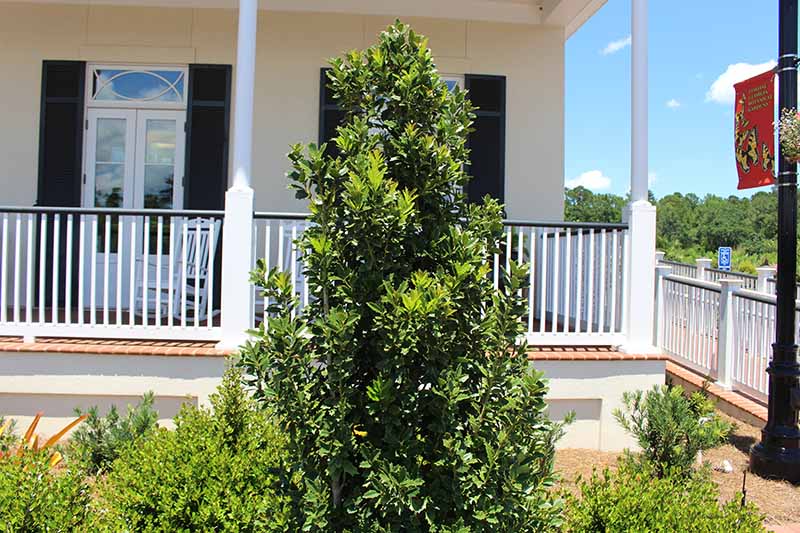
The reddish hue of the new growth provides interest in the spring garden, and the berries are a favorite with backyard birds during the winter months.
It’s easy to care for, quick-growing, and will add robust, evergreen beauty to your yard.
In the winter, you can cut a few holly berry sprigs for indoor decoration and keep them in water for a week or two or use them for a festive holiday centerpiece.
Quick Reference Growing Guide
| Plant Type: | Woody evergreen shrub | Flower / Foliage Color: | Creamy-white / green and reddish-orange |
| Native to: | Cultivated hybrid | Maintenance: | Low |
| Hardiness (USDA Zone): | 6-9 | Tolerance: | Cold, drought, some shade |
| Bloom Time / Season: | Early to late spring | Soil Type: | Loose, organically rich |
| Exposure: | Full to part sun | Soil pH: | 5.0-6.5 |
| Spacing: | 5-6 feet (hedge), 9+ feet (specimen) | Soil Drainage: | Well-draining |
| Planting Depth: | Same as root ball | Maintenance: | Low |
| Height: | 15-20 feet | Attracts: | Birds |
| Spread: | 7-9 feet | Uses: | Foundation planting, hedges, privacy screen, specimen planting; cutting for vases |
| Growth Rate: | Fast | Family: | Aquifoliaceae |
| Water Needs: | Moderate | Genus: | Ilex |
| Common Pests and Diseases: | Leaf miners, spider mites, scale insects, whiteflies; leaf spot, powdery mildew, tar spot | Cultivar: | x 'Conaf' |
Oak Leaf You To It
Now that you know all about these tall, stately, tough plants, it’s time to find the perfect spot for one – or more – in your yard or garden.
Providing year-round interest with little effort on your part, Oak Leaf holly is versatile and dependable, so it’s time to add this evergreen to your garden planner!
Are you growing Oak Leaf holly? Share your tips and feel free to ask any questions in the comments section below.
And for more information about growing holly shrubs in your yard, check out these guides next:
- How to Grow and Care for American Holly Trees
- How to Grow and Care for Winterberry Holly
- Must-Have Tips for Growing Inkberry Holly
- How to Grow and Care for English Holly
© Ask the Experts, LLC. ALL RIGHTS RESERVED. See our TOS for more details. Product photos via Arbico Organics, Espoma, and Nature Hills Nursery. Uncredited photos: Shutterstock.
